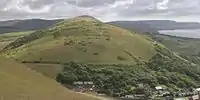Bindon Hill
Bindon Hill is an extensive Iron Age earthwork enclosing a coastal hill area on the Jurassic Coast near Lulworth Cove in Dorset, England, about 19 kilometres (12 mi) west of Swanage, about 6 kilometres (3.7 mi) south west of Wareham, and about 17 kilometres (11 mi) south east of Dorchester. It is within an Area of Outstanding Natural Beauty.
| Bindon Hill | |
|---|---|
 East end of Bindon Hill from Arish Mell gap. | |
| Highest point | |
| Elevation | 168 m (551 ft) [1] |
| Prominence | 94 m (308 ft) [1] |
| Parent peak | Lewesdon Hill |
| Listing | sub-HuMP |
| Geography | |
| Location | Dorset, England |
| Parent range | Purbeck Hills |
| OS grid | SY839802 |
| Topo map | OS Landranger 194 |

Hill fort

The main rampart and external ditch (univallate) run for over 2 km along an east-west ridge parallel to the coast, which lies about 750 m to the south. The ridge rises to 168 m and the cliffs are 30–120 m high. At the western end, an incomplete series of ramparts curve back to the cliffs of Lulworth Cove. At the eastern end, the main rampart reaches the cliffs on the north side of Mupe Bay. The total enclosed area is about 110 ha.
The enormous enclosed area, lack of evidence of settlement in the interior, and the impossibility of effectively defending such a large perimeter, all suggest it was primarily an enclosed pasture for domesticated animals, not a strategic tribal hill fort.
Accessibility
Bindon Hill is only accessible when the Lulworth Ranges are open to the public. It can be reached by a short walk from West Lulworth, or alternatively via the South West Coast Path from Lulworth Cove. The ranges are owned by the Ministry of Defence (MoD) and is part of the Armoured Fighting Vehicles (AFV) Gunnery School. The ranges are more than 2,830 hectares (7,000 acres),.[2] Visitors are advised to keep to official footpaths and abide to local site notices, because tanks and Armoured vehicles are used in this area. Safety warnings about explosives and unexploded shells are posted nearby by the MoD and there is a flashing warning lamp situated on the hill, which is illuminated when the ranges are in use.[3]
References
- Database of British and Irish Hills at www.hill-bagging.co.uk. Accessed on 30 Mar 2013.
- "Public access to military areas". web page. Ministry of Defence. 12 December 2012. Retrieved 19 December 2012.
- "Safety and access restrictions: Lulworth ranges". Retrieved 2010-11-16.